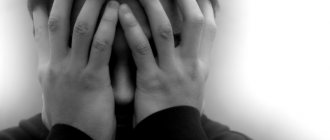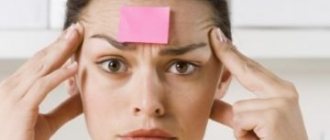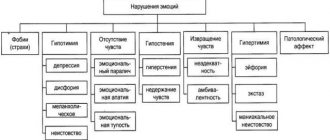- Published by: Laima Jansons
Hallucinations are a person’s perception of images and sensations that have no real stimulus. With hallucinations, all visual, olfactory, tactile, taste and other sensations arise in a person’s consciousness, without having an external manifestation. Typically, people suffering from mental or neurological disorders, organic diseases and functional disorders of the brain, who are under the strong influence of alcohol, psychotropic substances (drugs), and toxins, hallucinate. Sometimes hallucinations occur due to overwork, insomnia and other conditions.
Photo 1. If a person sees, hears or feels something that is not there, then he is hallucinating. Source: Flickr (Irvin Vallecillo)
Definition
The scientific concept of “hallucination” was formulated by the French psychiatrist Jean-Etienne Dominique Esquirol in his work “Manual of Psychiatry,” written in 1838. He wrote that a hallucination is an actual sensation experienced when a person is convinced of its presence.
Moreover, within the reach of his senses there is no external object that can induce such sensations. The definition makes it clear that hallucinations are accompanied by a disturbance in the sphere of perception and the presence of a strong belief in an initially erroneous judgment.
Subsequently, other specialists in the field of psychiatry formulated their own definitions of hallucinations. For example, Russian and Soviet psychiatrist Viktor Osipov noted in 1923 that a hallucination cannot be called simply a certain idea; it also cannot be a memory due to the impossibility of containing such sensory coloring, which forms a high degree of perception of something as happening in reality.
Russian psychiatrist Sergei Korsakov, one of the founders of the nosological trend in psychiatry, defined hallucinations as a connection of ideas and sensations corresponding to those phenomena or objects that do not currently affect the human senses.
The definition of hallucinations has also varied depending on the senses affected.
French psychiatrist and neurologist Jules Baillarger back in the mid-19th century. divided hallucinations into:
- auditory;
- visual;
- taste;
- olfactory;
- tactile (tactile);
- hallucinations of muscle sensation;
- imaginary sensations in the internal organs.
This classification has constantly expanded. For example, the German psychiatrist Karl Ludwig Kahlbaum introduced the concept of “functional hallucination” in relation to auditory influences in 1874. He noted that such false ideas arise in a person in the presence of external sound stimuli.
Hallucinations in the form of voices or any sounds appear in the background:
- the sound of flowing water;
- howling wind;
- running vehicle engine;
- device noise.
The modern definition of hallucination interprets the phenomenon as false or distorted images, as well as a deceptive sensory perception of the world, which can arise either as a result of illness or under the influence of chemicals. It is believed that hallucinations occur as a result of mental illness, the use of psychotropic substances, or extreme fatigue.
Clinical characteristics of true and false hallucinations
| Sign | True hallucinations | False hallucinations |
| Awareness of a hallucinatory image | It has the character of objectivity and reality, in the patient’s mind it is indistinguishable from the image of real perception | It is recognized as something subjective and at the same time anomalous, very different from real images, ideas, fantasies and true hallucinations |
| Judgment on the method of capturing a hallucinatory image | Confidence in the usual way of "perception" by one of the real analyzers | Confidence in an unusual perception by a non-existent analyzer (“inner self”, “inner eye”, “inner ear”, etc.) |
| Identification of a hallucinatory image with a real one | Complete, with alienation of the hallucinatory image from the subject | Absent, the hallucinatory image carries special qualities that allow the subject to distinguish it from the real one |
| Projection of a hallucinatory image | As a rule, into the physical material world, into real space within the reach of the analyzer | As a rule, in the subjective space, often beyond the reach of the analyzer |
| Feeling "done" | Always missing | Almost always happens |
| Actual behavior (correspondence of behavior to the content of hallucinatory experiences) | Almost always observed | Behavior is almost always dissociated from the content of hallucinations |
| Social confidence (the hallucinator's belief that others see the same images) | Occurs in almost all cases | Almost always missing |
| The hallucinatory image is dangerous | More often the life, health and well-being of the patient and his loved ones | More often the mental sphere of the patient |
| Daily fluctuations in symptom severity | As a rule, in the form of increased hallucinatory experiences, up to hallucinatory workload in the evening and night time | As a rule, there are no |
| Flow | Most often acute, relatively short-lived | Most often chronic, subacute, protracted |
A special group of disorders consists of the so-called psychosensory disorders , in which it is not the sensation directly emanating from the senses that is disrupted, but their synthesis, i.e. with them, recognition of objects is not impaired, but their qualities (color, shape, size, etc.) are painfully transformed.
Psychosensory disorders manifest themselves:
- Changes in the color of surrounding objects (red color - erythropsia, yellow - xanthopsia).
- Metamorphopsia - distortion of the shape and surface of objects of their size (increase - macropsia, decrease - micropsia, curvature - dysmegalopsia).
- Hypermetamorphosis - lack of hierarchical concentration of attention. Everything around you is equally important and is the center of attention.
- Doubling of objects.
- Feeling of objects being unstable and falling.
— Rotate the environment 90 or 180 degrees
— Impaired perception of time - acceleration, deceleration, stopping of time (“time is shadowed endlessly”, “time has stopped completely”)
-Autometamorphopsia (body diagram disorder) - a change in the size, shape and number of individual parts of the body (“the arms are swollen and do not fit under the pillow”, “the arms are lengthened and hang down to the floor”, “the head does not fit in the room”).
Psychosensory disorders also include such disorders of self-awareness as the phenomena of depersonalization and derealization.
Depersonalization is the patient’s painful experience of his own change, loss of self-identity, loss of his own “I”.
Derealization is a feeling that the world around us has inexplicably changed, has become “unreal”, “alien”, “artificial”, “specially adjusted” (everything around is gray, monotonous, as if through a veil).
Unlike psychosensory disorders, perception disorders in this case do not affect the physical properties of surrounding objects, but concern their inner essence.
Symptoms such as those already seen
(déjà vu) and
never seen
(jamais vu) - an unfamiliar environment seems familiar or a familiar one seems unfamiliar, respectively.
Thinking disorders.
Thinking is a process of mental activity, which is the main way of ordering, structuring the picture of the world, establishing cause-and-effect relationships between objects and phenomena in human life, and understanding their essence. Based on sensory knowledge, thinking transforms it, allowing one to obtain knowledge about such properties and relationships of objects that are insufficient for sensation and perception.
The thinking process is carried out in the form of certain intellectual operations: analysis, synthesis, comparison, generalization, abstraction and concretization.
Analysis is the mental division of an object, phenomenon, situation into its individual constituent elements, parts, sides.
Comparison – comparison of objects according to the characteristics and properties identified during the analysis. Identity or difference is established.
Abstraction is the selection of one or several aspects of a phenomenon that are significant in some respect and abstraction from all others.
Generalization is an operation that identifies features common to many objects or phenomena, on the basis of which their grouping is possible.
Synthesis is an operation, the result of which is complete and holistic knowledge of an object or phenomenon.
Concretization - consideration of a given specific phenomenon in the context of general patterns, identification of the most significant properties and connections with other objects and phenomena.
The process of mental activity occurs in concepts, judgments and conclusions.
1. A concept is a category developed by the experience and knowledge of mankind that reflects the essence (essence) of objects and phenomena, i.e. reflection in consciousness of the essential properties of objects (house, garden, color). Concepts are divided into concrete (names of objects, actions), abstract (designation of class and gender affiliation) and collective (forest, city).
2. A proposition is a statement that contains a statement regarding some object (this apple is red, the nightingale is a songbird).
3. Inference - a logical conclusion arising from existing knowledge expressed in judgments. There is a distinction between inductive inference, when a general conclusion is made on the basis of a number of particular judgments (N experiences a headache and pain in the neck, complains of general weakness, has a fever - three private judgments, and the general conclusion arising from them - N is sick). In the second type - deductive inferences, on the contrary, from some more general position, a particular conclusion is drawn (doctors are specialists with higher medical education and work in a hospital. M - has a diploma from a medical university and works as a resident, therefore, M - doctor).
Quantitative thinking disorders:
1. Slowing down of thinking (bradyphrenia) – a decrease in the number of associations per unit of time.
2. Sperung - a break in thinking associated with a stop in the associative process.
3. Acceleration of thinking (tachyphrenia) - characterized by the ease of associations, their superficiality, and a rapid transition from one thought to another.
Qualitative thinking disorders:
With a violation of the purposefulness of the thought process:
1. Thorough thinking – excessively getting stuck on unimportant details;
2. Specification – difficulty in separating the main and the secondary;
3. Reasoning – empty, unfocused reasoning, fruitless philosophizing;
4. Perseveration – getting stuck on one association;
5. Symbolism - manifests itself in the fact that the patient sees a special meaning, a “sign” in the words and actions of those around him.
In violation of logical laws:
1. Paralogical thinking - the patient draws logically incorrect conclusions from correct logical premises;
2. Discontinuity – the grammatical structure of speech is not broken, but there is no logical connection or meaning in the content of the patient’s statements;
3. Incoherence ( incoherence ) – a complete breakdown of speech, when not only the meaning, but also the grammatical structure of phrases disappears;
4. Slipping - moving from one thought to another;
5. Verbigerations - stereotypical repetition of the same words or phrases with an element of compulsion.
Related to the content of judgments:
1. Neologisms are made-up words, the meaning of which is understandable only to the patient;
2. Overvalued ideas - dominant in the mind, arising on the basis of real facts, the significance of which is sharply exaggerated due to an excessive emotional reaction to them. Due to their emotional intensity, they distort reality, although they are outwardly plausible;
3. Obsessions (obsessions) – thoughts that persistently arise in the patient’s mind, the appearance of which he experiences emotionally, because considers them unnecessary and burdensome, tries to get rid of them, but cannot do it on his own. With obsessions, there is criticism of experiences. Obsessive ideas rarely arise as an independent symptom - they are usually accompanied by other obsessive phenomena: obsessive fears (phobias), obsessive desires (compulsions) and actions (rituals);
4. Delusional ideas are erroneous conclusions that cannot be corrected, arise on a painful basis, completely take over the patient’s consciousness, determine his behavior and are prone to further progression.
According to the degree of completeness of the system of delusional conclusions (pathological system of evidence), delusions are usually divided into systematized and unsystematized.
Systematized delirium is characterized by an extensive system of evidence that “confirms” the plot underlying the pathological ideas. All the facts given by the patient are interconnected and have an unambiguous interpretation. As the disease progresses, an increasing number of reality phenomena are included in the delusional system, and the thinking process itself becomes more and more detailed, with the unconditional preservation of the main painful idea. If there is a pronounced systematization of delusions, one should assume a longer, chronic nature of the mental disorder. Acute conditions are often characterized by unsystematized delirium. The same delusion can also be observed with rapidly progressing organic lesions of the brain, when, along with the disintegration of the psyche (the formation of dementia), the previously harmonious system of delusional constructs also disintegrates.
Delirium is also usually divided into the so-called primary and secondary ( although, according to various researchers, this division is conditional).
In primary delusions, the patient’s delusional constructions are primarily determined by a disorder in the sphere of thinking, leading to an inadequate interpretation of actually existing phenomena (hence another name for this delusion - interpretive ).
Secondary delusions arise on the basis of existing disorders in other areas of mental activity, in the presence of other psychopathological phenomena (hallucinations, affective disorders, memory disorders, etc.).
Induced delusion is a kind of “contagion”, the transfer of the delusional experiences of a primarily ill person (inducer) to another person for whom the inducer is an authority (room neighbors, relatives, friends). Moreover, if the induced person is mentally healthy, then he plays the role of only a “repeater”, and when communication with the inductor ceases, these ideas are quickly destroyed.
Residual delirium occurs after a state of disturbed consciousness has been suffered and is built on the basis of associated memory disorders (such as “insular memories”), i.e. criticism returns to the patient to the transferred state, but “islands” of uncriticality remain. For example: a patient, after experiencing delirium, during which he believed that he was in a secret laboratory where experiments were being carried out on the amputation of lower extremities and the implantation of metal analogues, a few days later, in a conversation with a doctor about his condition, he said: “Doctor, I I understand that it was a mental disorder, that everything was a dream, that, in fact, I was in a psychiatric hospital. All clear. Just tell me, where did the cut off legs go?”
Stages of delirium formation:
- trema - delusional premonition, anxiety, detection of the source of the formation of a new logical chain;
- apophene - the formation of a gestalt of delirium - the formation of a delusional idea, its crystallization, sometimes sudden insight;
- apocalypse - the collapse of the delusional system due to therapy or affective exhaustion.
Dynamics of delirium.
During the development of mental illness, delusional ideas undergo a certain evolution. The French psychiatrist Magnan, as a result of many years of research, found that if delirium is not influenced by drugs, it has the following dynamics:
Delusional prodrome or delusional mood. The patient, without any reason or reason, feels severe physical and mental discomfort, diffuse anxiety associated with real events and the environment, experiences a feeling of impending disaster, misfortune, tragedy, wary suspicion, and internal tension. This period, being a kind of precursor to delirium, lasts from several hours to several months.
Crystallization of delirium. The patient develops delusional ideas of a persecutory nature. Crystallization of delirium occurs as an insight. Suddenly, the patient realizes why he felt bad (restless, anxious) for a certain period; it turns out that he was exposed to some kind of rays from a neighboring house and employees of foreign intelligence services tried to “confuse” him. The second stage, as a rule, lasts many years, sometimes decades and even the entire life of the patient.
Formation of delusions of grandeur. In painful consideration of why he, and not any other person, is being persecuted and read, the patient gradually comes to the conviction that the choice fell on him, since he has a “bright head, extraordinary abilities, the most talented brains” or he is a side branch of the famous dynasty of nuclear physicists. This is how delusions of grandeur are formed with corresponding pretentious behavior and an absurd lifestyle. Patients periodically organize “grand-ducal receptions” or “gather on space expeditions.” The transition of delirium to the stage of greatness usually indicates an unfavorable course of the endogenous process.
The collapse of the delusional structure occurs after the stage of delusions of grandeur and indicates such a degree of dementia when the patient’s psyche is no longer able to maintain a harmonious, albeit constructed according to the laws of paralogic, delusional structure. The delusion breaks up into separate fragments that no longer determine the patient’s behavior style. So a patient who proudly claims that he is the richest person on the planet, after a few minutes, obsequiously asks his roommate for a few rubles to buy cigarettes or picks up cigarette butts. At the same time, minute-long episodes of delusions of grandeur become increasingly rare over time and can appear only as reflections against the background of the final (apathetic-abulic) state.
The plot of delirium is the plot, the content of a delusional thought, which is emotionally experienced by the patient. In accordance with the dominant emotion, three groups of plots are distinguished (see Table 2).
Table 2.
The main plots of delirium and their clinical variants.
| Persuasive delirium | Depressive delirium | Delusions of grandeur |
| Delusions of persecution Impacts Poisoning Material damage Jealousy Staging Relationships Litigative | Self-humiliation Self-accusation Sinfulness Hypochondriacal Dysmorphomanic Delirium Cotard | Riches Invention Reformation High Origin Love |
1. Persecutory delusions : persecution, poisoning, material damage, jealousy, influence, relationships, witchcraft (damage), possession. The last three concepts constitute archaic forms of delirium, the content of which directly follows from the ideas existing in society.
Delusional ideas of persecution, especially at the stage of their occurrence, are often accompanied by anxiety, fear, and often act as a determining factor in the patient’s behavior, which can make him dangerous to others and may require emergency involuntary hospitalization. The danger intensifies when the “evil” caused, in the patient’s opinion, finds a specific carrier from the immediate environment.
2. Depressive delusions can occur in the following clinical variants: self-accusation, self-abasement, sinfulness, evil power, hypochondriacal, dysmorphomanic, nihilistic. Each of these options may have its own characteristics and plot. However, they all exist against a background of low mood. Establishing the sequence of appearance of psychopathological phenomena is of diagnostic significance: what is primary – delusional ideas of the corresponding content or depressive mood.
Depressive ideas can determine the behavior of patients and, accordingly, lead to social danger for the patient (primarily for himself, since attempts at suicide are possible).
The most intense and complex in content depressive delirium occurs during prolonged anxious depression. In these cases, Cotard's delirium often develops.
Cotard's delusions are characterized by fantastic ideas of denial or enormity. If there are ideas of denial, the patient reports his lack of moral, intellectual, and physical qualities (no feelings, conscience, compassion, knowledge, ability to feel). In the presence of somatopsychic depersonalization, patients often complain of the absence of the stomach, intestines, lungs, heart, etc. etc. They can talk not about the absence, but about the destruction of internal organs (the brain has dried out, the intestines have atrophied). The idea of denying the physical “I” is called nihilistic delusion. Denial can extend to various concepts of the external world (the world is dead, the planet has cooled down, there are no stars, no centuries).
Often, with Cotard's delusions, patients blame themselves for all sorts of past or future world cataclysms (delusions of negative power) or express ideas about eternal torment and the impossibility of dying (delusions of painful immortality).
3. Delusional ideas of grandeur are always noted against the background of increased self-esteem of the patient. The patient’s statements about his extraordinary abilities, position or activities acquire a grandiose scope, and their inadequacy is striking to any person (“I rule the globe”). Ideas of grandiosity are most often characteristic of the later stages of mental illness or of severe, rapidly progressing and dementing organic brain lesions
Table 3.
Kinds
Hallucinations in psychology are phenomena that are classified into types according to various criteria. For example, depending on the correlation of the hallucinatory image with reality, true and pseudohallucinations are distinguished. The first type is characterized by a person’s conviction that what is happening is realistic.
The patient can interact with the objects of hallucinations, hear them clearly, feel touch and smell them vividly. A person has no doubt about the truth of what is happening. Pseudo-hallucinations are an image in a person’s mind in the absence of a really present object of perception.
This type of hallucination differs from true ones by the lack of identification with actually present objects. The patient understands that his visions are not objective; also, hallucination images do not interact with a person or real objects.
You can also classify hallucinations depending on their effect on the senses:
| Type of hallucination | Description |
| Visual | May appear as spots before the eyes, sudden flashes of light, or blurred vision. Also, such hallucinations can have objective content, that is, they can be presented in the form of animals, people, or fictional characters. This symptom is typical for patients with schizophrenia. |
| Auditory | Sound perception occurs without auditory stimulation. The patient may feel:
The patient may hear voices that differ depending on the content: 1. Commentary voices. They pronounce a person's actions. 2. Imperative voices. The most dangerous type of hallucination is when the patient hears orders and calls that force him to take some action. 3. Duplicate voices repeat words or phrases spoken by the patient. 4. Statemental voices discuss any events of the past or present in a person’s life. |
| Olfactory | They are characterized by a pathological condition in which a person perceives smells and tastes that do not actually exist. Most often, the pathological condition occurs against the background of any mental disorders, such as schizophrenia, and other deviations of varying severity. |
| Tactile | During hallucinations, a person feels the presence of an object (creature) on the body that does not exist, as well as its possible movement throughout the body. This may cause a feeling of extreme heat or cold. |
Symptoms
Possible symptoms of true hallucinations include the following:
- logically sequential appearance of images (the voice can announce hallucinations that subsequently appear in the visual field);
- voices speaking in an orderly, commanding tone. They may encourage you to perform any actions that are sometimes dangerous for the patient and other people. This symptom can manifest itself in suicidal behavior, schizophrenia;
- hallucinations occur in response to the impact of a real stimulus on any analyzer (auditory, visual, tactile, olfactory). For example, turning on the light (a stimulus for the visual analyzer) causes an auditory hallucination in the form of voices and orders;
- hallucinations that occur outside the patient’s field of sensitivity (for example, visual hallucinatory images are perceived by the patient behind him).
Possible symptoms of pseudohallucinations:
- auditory illusions, that is, “echoes” of thoughts or internal conversations in several voices, while the sound source can be located in an unnatural place, or at a distance beyond the limits of perception;
- false ideas about the motor and speech apparatus. They are distinguished by the feeling that the speech apparatus begins to function against the will; it seems that the tongue pronounces words or even entire sentences on its own;
- the phenomenon of traces (“visual echo”) is a perceptual disorder in which moving objects are seen as a series of discrete images. It occurs in mentally healthy people, for example, when overworked;
- gustatory and olfactory illusions are represented by the subjective sensation of non-existent tastes and smells, often unpleasant to humans;
- hallucinations that evoke auditory and visual images that remind a person of the events of the day.
Causes
Hallucinations in psychology are a disorder that manifests itself in varying degrees of severity, which is influenced by the reasons for their occurrence.
Causes of hallucinations:
- Severe psychological shock experienced by the patient. The content of hallucinations is clear and logical: they are close to a person’s experiences and are emotionally rich. It often happens when a hallucination completely replaces reality, which the individual would like to ignore due to its traumatic nature.
- Poisoning with various substances (for example, tetraethyl lead, a component of leaded gasoline).
- Alcoholic psychoses. This condition is often accompanied by specific hallucinations. They usually develop in people who have a fairly long history of drinking alcohol. Most often, with alcoholic psychosis, the images that arise in the mind cause a person to feel a sense of horror.
- Rheumatic diseases of the heart and joints.
- Tumors in the brain.
- Long-term lack of sleep.
- Decompensation of cardiovascular diseases. Hallucinations disappear as the circulatory system is restored and the general psychophysical condition of the patient improves.
- Mental illnesses. Common ones include schizophrenia, epilepsy, and psychosis.
- Age. As a result of the aging of the body, changes occur that entail a failure of the sensory organs.
- Syphilis of the brain. Against the background of the disease, the patient develops severe hallucinations. Their main manifestation is sharp sounds and voices, as well as unpleasant visual images.
- Infectious diseases.
- Prolonged insomnia.
- Consumption of plants containing toxic substances that affect the central nervous system.
Causes of hallucinations
What can cause hallucinations in a person?
Researcher A.S. Shmaryan (1949), studying hallucinations as the main positive symptom of schizophrenia, suggested that damage to the temporal lobes of the brain contributes to this perceptual disorder. For example, a tumor in this area often causes hallucinations.
Observing patients with a disease associated with hallucinations, a number of researchers noted a structural and functional disorder in the superior temporal gyrus and damage to the anterior section of the superior gyrus of the left temporal lobe of the brain.
The surgical method of treating epilepsy, in which electrical stimulation of the superior temporal gyrus occurs, can also lead to various acoustic effects: noise, ringing, rumble.
Damage to the right temporal region causes olfactory, gustatory and musical hallucinations. If the left region is affected, verbal hallucinations may occur with severe anxiety.
Auditory hallucinations occur when not only the temporal lobe of the brain is affected, but also its other structures that take part in the functioning of the hearing analyzer. There is a hypothesis that states that in patients with schizophrenia, when the processes responsible for recognizing internal speech are disrupted, an erroneous perception of their own internal speech occurs as speech from the outside, addressed directly to them.
In addition to the above, the appearance of various types of hallucinations can provoke a state of intoxication of the body with certain drugs or substances.
Diagnostics
In psychology, the diagnosis of hallucinations is aimed, first of all, at differentiating this pathology from illusions that may be characteristic of mentally healthy people and do not require medical intervention.
To do this, you need to contact a neurologist, psychiatrist, oncologist or narcologist in order to make a correct diagnosis and formulate an effective treatment program for hallucinations.
As part of pre-medical care, it is necessary to prevent the increase in agitation and the strength of hallucinations, as well as to prevent socially dangerous actions when the patient can harm himself or others. After consultation with a specialist, the patient will be provided with qualified medical care. Direct diagnosis is based on the doctor’s observations of the patient’s behavior.
The main criteria by which hallucinations are diagnosed:
- constant alertness;
- special care;
- the patient often listens and looks closely at something;
- rave;
- facial expressions that have nothing to do with objective conditions;
- talking out loud;
- reactions to images in the form of plugging ears, closing eyes, trying to hide.
Main features[ | ]
There are three main features that distinguish pseudohallucinations from true hallucinations:
- intraprojection
. Pseudohallucinations arise only in the subjective mental space of the patient[3], who perceives them not with the usual senses, but “sees with the inner eye”, “hears with the inner ear”[4]. - sensual brightness
. As V.Kh. Kandinsky noted, the images of pseudohallucinations are much more realistic than “images of memories and fantasies” [5] (which can be traced not only in general, but also in the smallest details [5] [3]), and disappear from memory immediately , rather than gradually[5][3]. - feeling of being “done”
. The patient perceives illusory images as the result of violent influence from the outside. This alienation of one’s own mental act makes pseudohallucinations similar to other manifestations of the Kandinsky-Clerambault syndrome, in particular, delusions of influence.
Treatment methods
Hallucinations in psychology are a disorder that can only be treated under medical supervision. The main method of treatment is medication. In order to alleviate negative symptoms, you can use folk recipes to relieve fatigue, tension, and attacks of hallucinations. Also, depending on the causes of the disorder, psychotherapy may be used as part of the course of treatment.
Drug treatment
For hallucinations, the doctor may prescribe the following groups of drugs:
- sleeping pills (during non-acute manifestations of the disease);
- tranquilizers (for acute illness);
- neuroleptics;
- mild sedatives.
List of drugs that may be included in the drug treatment of hallucinations:
- Quetiapine. The drug is an antipsychotic and is recommended for short-term treatment during manic periods. Its action is aimed at combating the negative symptoms of acute mania; it, unlike lithium, has much fewer side effects.
Quetiapine
- Risperpet. The drug is prescribed only for acute forms of schizophrenia and inhibits the active development of symptoms of the disease, eliminates hallucinations, delusional states, increased aggression and depression.
- Tianeptine. This antidepressant improves mood, increases overall muscle tone and relieves symptoms of depression.
- Abilify. Prescribed simultaneously with antidepressants for dementia, schizophrenia, depression. However, it must be remembered that this drug may cause increased anxiety.
- Deanola Aceglumate, Pantogam. The drugs are nootropic substances that restore attention, memory and the ability to concentrate.
- Grandaxin. It is used for increased tension, fear, autonomic disorder, and decreased activity.
- Phenazepam, diazepam, chlordiazepoxide, medazepam. These tranquilizers relieve fear and anxiety and relieve emotional stress. They have a pronounced calming effect and normalize sleep.
- Paroxetine. The antidepressant is a new generation drug that quite quickly relieves anxiety and depression and is well tolerated by patients.
- Sleeping pills (Tripsidan, Donormil, Andante). The drugs are used for sleep disorders.
Also, during treatment, you need to know that some medications from different pharmacological groups have an undesirable side effect in the form of the development of false images.
These medications include:
- Acyclovir;
- Chloroquine;
- Suprastin;
- Triazolam;
- Trazodone;
- Amphoteric;
- other.
Traditional methods
Traditional methods for the treatment of hallucinations are complex and necessary to alleviate symptoms, calm and normalize sleep.
Traditional methods to relieve symptoms of hallucinations:
- A remedy for insomnia. To prepare, you need to mix 200 ml (or 290 g) of honey with 1 tbsp. l. apple cider vinegar. Take the resulting product 1-2 tbsp. l. daily before bed. People with stomach ulcers are advised to add just a couple of drops of apple cider vinegar.
- To get rid of stress, a healing infusion of linden flowers is prepared. For this, 1 tbsp. l. inflorescences are brewed in 200 ml of boiling water and allowed to stand for at least 20 minutes. You can drink this remedy as tea, 200 ml up to 3 times a day. The drink is consumed for no more than 1 month in a row, after this period you need to take a break, after which you can resume treatment.
- Soothing oil. The product will help reduce irritability and increased excitability. To use, you need to mix 200 g of flowering mignonette and 0.5 liters of sunflower oil. Infuse the resulting liquid for about 2 weeks in a cool room, shaking occasionally. After time, use the solution by rubbing a small amount into your temples no more than 2 times a day.
- Angelica tincture perfectly relieves nervous tension. It is prepared like this: 10 g of the root and 30 g of the green part of the plant are crushed and poured with 500 ml of white wine. Infuse the mixture for 24 hours, shaking occasionally. After time, the tincture is filtered and consumed twice a day, a quarter glass.
- Blueness for calm. For the decoction, you need to take 6 g of dry crushed cyanosis roots per 1 tbsp. warm water, boil for 30 minutes, take 1 tbsp. l. 2 times in the afternoon after meals.
- Recipe from resin for hallucinations. 2 tbsp. l. Pour crushed gum grass into a thermos with one glass of boiling water, leave for 2 hours. Strain the solution and take 1 tbsp. l. 3 times a day, regardless of food.
- Recipe for hallucinations. It is necessary to prepare medicinal comfrey - 1 tsp. and 1 l. water. Preparation and use:
- Pour medicinal comfrey with a liter of water.
- Bring the mixture to a boil, let simmer for 10 minutes over low heat.
- Let the solution sit for about an hour and strain.
- You need to drink the decoction during the day; the treatment course lasts about 10 days.
Other methods
If the causes of hallucinations are psychotic disorders, which are a manifestation of schizophrenia, bipolar disorder, or even neurotic disorders, then treatment of the underlying disease is necessary, when remission is achieved, hallucinations cease to bother the patient.
Since hallucinations most often accompany mental disorders and abnormalities, it is necessary to consider the main types of therapy for the treatment of the original disease:
- cognitive behavioral therapy. It allows you to identify and study manic ideas and suicidal tendencies. Identifying cognitive errors in your thinking during periods of mania and depression is an important element of cognitive behavioral therapy; this helps the patient to independently analyze his symptoms, which means it makes it easier for him to deal with them and control his actions;
- dialectical behavior therapy. It is a modified form of cognitive behavioral therapy adapted for the treatment of mood disorders. Therapy is aimed at identifying your emotions, understanding them and living them. The basis of working with patients is aimed at understanding and learning basic life skills;
- family therapy, art therapy. These therapies are complementary, but useful for working through your emotions and relationships with people. Mental disorder is a difficult disease for the patient’s loved ones to accept, so family therapy will help establish contact between the patient and his family. Art therapy is a way for the patient to express his emotions through creativity, which is an important additional part of basic psychotherapy.
Possible complications
Hallucinations in psychology are a disorder that is often accompanied by other mental disorders. If left untreated, they can lead to negative consequences.
In advanced stages the patient:
- makes suicide attempts;
- may cause harm to others;
- becomes too excited, his speech becomes incomprehensible to others;
- drinks alcohol in large quantities;
- becomes dependent on drugs and other psychoactive substances;
- loses touch with reality;
- begins to react aggressively to attempts to help;
- becomes insane.
Hallucinations can also trigger the onset of other mental disorders, which reduces the likelihood of a quick recovery from treatment. If the patient was already initially ill with schizophrenia, there is practically no possibility of complete recovery in the later stages.
Many complications from hallucinations can be deadly for both the patient and the people around him, so the disorder requires timely and comprehensive treatment.
Hallucinations as a symptom may indicate a number of functional disorders of the brain and psychiatric diseases and cannot be treated at home.
In psychology, this disorder is defined as a disturbance of perception that must be corrected immediately after the onset of symptoms in the form of auditory, visual, olfactory and tactile illusions of influence.
What you can and cannot do if you have hallucinations
The main problem with hallucinations is that the person perceiving them cannot distinguish between objects visible in the mind and real objects. Few people are able to reason sensibly and logically, seeing images that are indistinguishable in their minds from real ones. If your loved one begins to behave strangely (talking to himself, shaking off invisible insects, getting scared), you need to find out the reason . In a trusting relationship, sooner or later he admits that he is hallucinating in order to relieve psychological stress. In this case, you need to contact a neurologist or psychiatrist to undergo an examination.
During the acute stage of a hallucination in a loved one, you cannot:
- leaving him alone (especially if these are imperative or verbal hallucinations);
- leave dangerous objects in his sight (knives, scissors - any piercing or cutting objects);
- argue with him, prove the unreality of visible images;
- make fun of the patient;
- give sedatives or antipsychotics without consulting a doctor;
- look for the source of visual or sound images together with the patient.
It is necessary to consult a neurologist or psychiatrist as soon as possible. The specialist will prescribe an examination for brain diseases and intoxications. The doctor should collect a family history to rule out hereditary factors for mental illness (especially schizophrenia). An MRI of the brain is required to check for malignant tumors.










